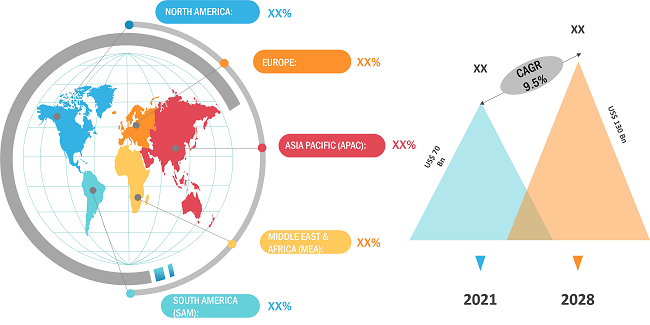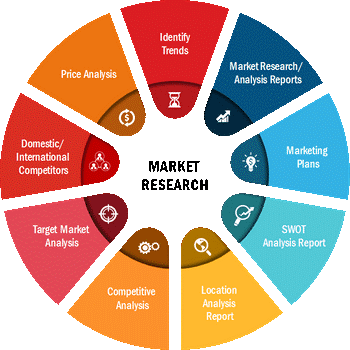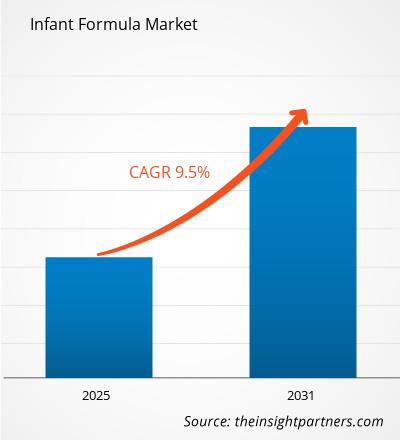Il mercato del latte artificiale ha rappresentato circa 70 miliardi di dollari nel 2021 e si prevede che supererà quello statunitense 130 miliardi di dollari entro il 2031 con un CAGR stimato del 9,5% tra il 2022 e il 2031.
Si prevede che il mercato delle formule per neonati assisterà a una crescita significativa durante il periodo di previsione. La domanda di latte artificiale è aumentata a causa della crescente attenzione alla cura e alla nutrizione infantile, alle crescenti attività di ricerca e sviluppo e all’attenzione dell’industria sull’innovazione e sullo sviluppo di nuovi prodotti. La crescente adozione del latte artificiale da parte della popolazione della classe media nelle economie emergenti sta ulteriormente contribuendo alla crescita del mercato. Inoltre, si prevede che la propensione dei consumatori verso prodotti con etichetta pulita e di origine vegetale rappresenti opportunità di crescita per il mercato. Nei paesi sviluppati, la crescita del mercato degli alimenti per neonati è attribuito alla crescente consapevolezza sui benefici per la salute del latte artificiale.
DINAMICHE DEL MERCATO
Il latte artificiale è una formulazione appositamente progettata per i lattanti per promuovere la loro crescita complessiva e fornire benefici nutrizionali complessivi. Il latte artificiale è costituito da vari nutrienti come proteine, grassi, carboidrati, minerali, vitamine e altri che aiutano lo sviluppo generale dei neonati. Vari istituti e organizzazioni governative come l’Organizzazione Mondiale della Sanità (OMS), la Food Safety and Standard Authority of India (FSSAI) stanno regolamentando il latte artificiale per garantire l’alta qualità dei prodotti. Organizzazioni così rigorose riguardo alla qualità dei prodotti hanno spinto la propensione dei consumatori verso l'adozione dei prodotti.
AMBITO DI MERCATO
L'"Analisi del mercato globale delle formule per neonati fino al 2031" è uno studio specializzato e approfondito del mercato delle formule per neonati con particolare attenzione all'analisi delle tendenze del mercato globale. L’obiettivo del rapporto è fornire una panoramica del mercato degli alimenti per lattanti con una dettagliata segmentazione del mercato. Il rapporto fornisce statistiche chiave sullo stato del mercato dei principali attori del mercato ed evidenzia le principali tendenze e opportunità nel mercato delle formule per neonati.
Approfondimenti strategici
< strong>SEGMENTAZIONE DEL MERCATO
Il mercato globale degli alimenti per lattanti è segmentati in tipologia, categoria e canale di distribuzione. In base alla tipologia, il mercato è ulteriormente segmentato in formula di latte iniziale, formula di latte di proseguimento, formula di latte per bambini e formula di latte speciale. Per categoria, il mercato è diviso in biologico e convenzionale. In termini di canale di distribuzione, il mercato è classificato in supermercati e ipermercati, minimarket, vendita al dettaglio online e altri.
Il rapporto fornisce una panoramica dettagliata del settore, comprese informazioni qualitative e quantitative. Fornisce una panoramica e previsioni del mercato globale delle formule per neonati in base a vari segmenti. Fornisce inoltre stime sulle dimensioni del mercato e sulle previsioni dal 2021 al 2031 rispetto a 5 regioni principali: Nord America, Europa, Asia (APAC), Medio Oriente e Asia. Africa (MEA) e Sud America. Il mercato del latte artificiale per ciascuna regione viene successivamente suddiviso in sottosegmenti in base ai rispettivi paesi. Il rapporto copre l'analisi e le previsioni di 18 paesi a livello globale insieme alle tendenze attuali e alle opportunità prevalenti nella regione.
Dal punto di vista regionale, l'APAC ha dominato il mercato delle formule per neonati. Il dominio di questo mercato regionale è principalmente guidato dalla forte domanda che emerge dall’alto tasso di natalità. L'aumento del numero della popolazione attiva, l'aumento del reddito disponibile e l'aumento dei casi di malnutrizione tra i neonati sono tra gli altri fattori che aiutano il mercato delle formule per neonati.
La figura seguente mostra il trend di crescita dei ricavi nel mercato globale delle formule per neonati:
< span style="font-size: 10pt; font-family: verdana, geneva, sans-serif;">Fonte: The Insight Partners Analysis
Il rapporto analizza i fattori che influenzano il mercato delle formule per neonati sia dal lato della domanda che dell'offerta. Inoltre, valuta le dinamiche del mercato, ovvero i fattori trainanti, le restrizioni, le opportunità e le tendenze future, che influenzano il mercato durante il periodo di previsione. Il rapporto fornisce anche un'analisi esaustiva delle cinque forze di Porter che evidenzia i fattori che influenzano il mercato delle formule per neonati.
IMPATTO DELLA PANDEMIA DA COVID-19
L'epidemia di COVID-19 ha provocato una significativa carenza di latte artificiale a livello globale. La carenza è stata causata dall'interruzione della catena di approvvigionamento e dai recenti richiami di diversi prodotti per lattanti per problemi di contaminazione. Secondo lo studio condotto dal laboratorio UC Merced Lactation Attackment Technology and Child Health (LATCH) in collaborazione con UC Irvine e l’Università di Toronto nel maggio 2022, si è affermato che il 69% delle famiglie ha avuto difficoltà ad accedere al latte artificiale. Le interruzioni della catena di approvvigionamento hanno creato una carenza di materie prime, che ha influenzato la produzione e la distribuzione di vari prodotti, portando ad un aumento dei prezzi. I fattori sopra menzionati hanno ostacolato la redditività di vari produttori su piccola e grande scala. Tuttavia, dal 2021, la domanda di latte artificiale è aumentata a causa della crescente attenzione alla nutrizione infantile per il corretto sviluppo e il miglioramento dell’immunità. Ciò stimolerebbe l'approvvigionamento di latte artificiale, che alla fine si tradurrebbe in una notevole crescita del mercato durante il periodo di previsione.
ATTORI DEL MERCATO
I rapporti riguardano gli sviluppi chiave nelle strategie di crescita organica e inorganica nel mercato delle formule per neonati. Diverse aziende si stanno concentrando su strategie di crescita organica, come lanci di prodotti, approvazioni di prodotti e altro, inclusi brevetti ed eventi. Le strategie di crescita inorganica testimoniate nel mercato sono state acquisizioni, partnership e collaborazioni. Queste attività hanno aperto la strada all'espansione del business e della base clienti degli operatori del mercato. Con la crescente domanda di latte artificiale, si prevede che gli operatori del mercato avranno opportunità di crescita redditizie nel prossimo futuro.
Il rapporto include anche i profili delle aziende chiave in questo mercato, la loro analisi SWOT e le strategie di mercato. Inoltre, il rapporto si concentra sui principali attori del settore con informazioni quali profili aziendali, componenti e servizi offerti, informazioni finanziarie degli ultimi 3 anni e sviluppi chiave negli ultimi 5 anni. Di seguito è riportato l'elenco di alcune aziende impegnate nel mercato del latte artificiale:
- Nestlé
- Abbott
- Danone SA
- Arla Foods amba
- Bellamy's Organic
- The Kraft Heinz Company
- Perrigo Company plc
- Reckitt Benckiser Group PLC
- Burt's Bees
- HiPP GmbH & Co. Vertrieb KG
Il team di ricerca e analisi dedicato del partner Insight è composto da professionisti esperti con competenze statistiche avanzate e offre varie opzioni di personalizzazione nello studio esistente.

- Analisi storica (2 anni), anno base, previsione (7 anni) con CAGR
- Analisi PEST e SWOT
- Valore/volume delle dimensioni del mercato - Globale, regionale, nazionale
- Industria e panorama competitivo
- Set di dati Excel



Report Coverage
Revenue forecast, Company Analysis, Industry landscape, Growth factors, and Trends

Segment Covered
This text is related
to segments covered.

Regional Scope
North America, Europe, Asia Pacific, Middle East & Africa, South & Central America

Country Scope
This text is related
to country scope.
Trends and growth analysis reports related to Consumer Goods : READ MORE..
The List of Companies
1. Abbott Laboratories
2. Arla Foods amba
3. Bellamy's Organic
4. Danone Nutricia
5. Glanbia plc,
6. Mead Johnson and Company, LLC.
7. Nestle S.A.,
8. Perrigo Nutritionals
9. Pfizer Inc.
10. The Hain Celestial Group
The Insight Partners performs research in 4 major stages: Data Collection & Secondary Research, Primary Research, Data Analysis and Data Triangulation & Final Review.
- Data Collection and Secondary Research:
As a market research and consulting firm operating from a decade, we have published and advised several client across the globe. First step for any study will start with an assessment of currently available data and insights from existing reports. Further, historical and current market information is collected from Investor Presentations, Annual Reports, SEC Filings, etc., and other information related to company’s performance and market positioning are gathered from Paid Databases (Factiva, Hoovers, and Reuters) and various other publications available in public domain.
Several associations trade associates, technical forums, institutes, societies and organization are accessed to gain technical as well as market related insights through their publications such as research papers, blogs and press releases related to the studies are referred to get cues about the market. Further, white papers, journals, magazines, and other news articles published in last 3 years are scrutinized and analyzed to understand the current market trends.
- Primary Research:
The primarily interview analysis comprise of data obtained from industry participants interview and answers to survey questions gathered by in-house primary team.
For primary research, interviews are conducted with industry experts/CEOs/Marketing Managers/VPs/Subject Matter Experts from both demand and supply side to get a 360-degree view of the market. The primary team conducts several interviews based on the complexity of the markets to understand the various market trends and dynamics which makes research more credible and precise.
A typical research interview fulfils the following functions:
- Provides first-hand information on the market size, market trends, growth trends, competitive landscape, and outlook
- Validates and strengthens in-house secondary research findings
- Develops the analysis team’s expertise and market understanding
Primary research involves email interactions and telephone interviews for each market, category, segment, and sub-segment across geographies. The participants who typically take part in such a process include, but are not limited to:
- Industry participants: VPs, business development managers, market intelligence managers and national sales managers
- Outside experts: Valuation experts, research analysts and key opinion leaders specializing in the electronics and semiconductor industry.
Below is the breakup of our primary respondents by company, designation, and region:

Once we receive the confirmation from primary research sources or primary respondents, we finalize the base year market estimation and forecast the data as per the macroeconomic and microeconomic factors assessed during data collection.
- Data Analysis:
Once data is validated through both secondary as well as primary respondents, we finalize the market estimations by hypothesis formulation and factor analysis at regional and country level.
- Macro-Economic Factor Analysis:
We analyse macroeconomic indicators such the gross domestic product (GDP), increase in the demand for goods and services across industries, technological advancement, regional economic growth, governmental policies, the influence of COVID-19, PEST analysis, and other aspects. This analysis aids in setting benchmarks for various nations/regions and approximating market splits. Additionally, the general trend of the aforementioned components aid in determining the market's development possibilities.
- Country Level Data:
Various factors that are especially aligned to the country are taken into account to determine the market size for a certain area and country, including the presence of vendors, such as headquarters and offices, the country's GDP, demand patterns, and industry growth. To comprehend the market dynamics for the nation, a number of growth variables, inhibitors, application areas, and current market trends are researched. The aforementioned elements aid in determining the country's overall market's growth potential.
- Company Profile:
The “Table of Contents” is formulated by listing and analyzing more than 25 - 30 companies operating in the market ecosystem across geographies. However, we profile only 10 companies as a standard practice in our syndicate reports. These 10 companies comprise leading, emerging, and regional players. Nonetheless, our analysis is not restricted to the 10 listed companies, we also analyze other companies present in the market to develop a holistic view and understand the prevailing trends. The “Company Profiles” section in the report covers key facts, business description, products & services, financial information, SWOT analysis, and key developments. The financial information presented is extracted from the annual reports and official documents of the publicly listed companies. Upon collecting the information for the sections of respective companies, we verify them via various primary sources and then compile the data in respective company profiles. The company level information helps us in deriving the base number as well as in forecasting the market size.
- Developing Base Number:
Aggregation of sales statistics (2020-2022) and macro-economic factor, and other secondary and primary research insights are utilized to arrive at base number and related market shares for 2022. The data gaps are identified in this step and relevant market data is analyzed, collected from paid primary interviews or databases. On finalizing the base year market size, forecasts are developed on the basis of macro-economic, industry and market growth factors and company level analysis.
- Data Triangulation and Final Review:
The market findings and base year market size calculations are validated from supply as well as demand side. Demand side validations are based on macro-economic factor analysis and benchmarks for respective regions and countries. In case of supply side validations, revenues of major companies are estimated (in case not available) based on industry benchmark, approximate number of employees, product portfolio, and primary interviews revenues are gathered. Further revenue from target product/service segment is assessed to avoid overshooting of market statistics. In case of heavy deviations between supply and demand side values, all thes steps are repeated to achieve synchronization.
We follow an iterative model, wherein we share our research findings with Subject Matter Experts (SME’s) and Key Opinion Leaders (KOLs) until consensus view of the market is not formulated – this model negates any drastic deviation in the opinions of experts. Only validated and universally acceptable research findings are quoted in our reports.
We have important check points that we use to validate our research findings – which we call – data triangulation, where we validate the information, we generate from secondary sources with primary interviews and then we re-validate with our internal data bases and Subject matter experts. This comprehensive model enables us to deliver high quality, reliable data in shortest possible time.

 Ottieni un campione gratuito per questo repot
Ottieni un campione gratuito per questo repot